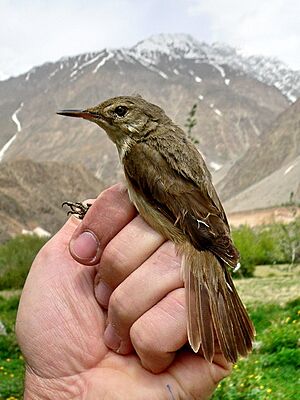Large-billed reed warbler facts for kids
Quick facts for kids Large-billed reed warbler |
|
|---|---|
 |
|
| An adult large-billed reed warbler caught at breeding grounds in the Pamir Mountains, Tajikistan | |
| Conservation status | |
| Scientific classification | |
| Genus: |
Acrocephalus (bird)
|
| Species: |
orinus
|
 |
|
| Distribution of Large-billed Reed Warbler Breeding Non-breeding | |
The large-billed reed warbler (Acrocephalus orinus) is a small bird that lives in reed beds and wetlands. For a long time, it was known as "the world's least known bird." This is because scientists only had one single bird specimen collected in India way back in 1867! It was like a real-life mystery.
But then, in 2006, this amazing bird was found alive again in Thailand. Scientists used DNA from its feathers to prove it was the same species. The bird was then safely released. After this exciting rediscovery, another specimen was found in a museum collection. Since then, more discoveries have been made. Scientists have even found where it breeds in places like Afghanistan, Kazakhstan, and Tajikistan. One bird was also seen in Bangladesh in 2011.
What Does It Look Like?
The large-billed reed warbler has feathers that are mostly olive-brown on its back, wings, and tail. Its belly and the underside of its wings are a pale, creamy color.
This bird is about 5 in (130 mm) long. Its tail is about 2.3 in (58 mm) and its wing is about 2.4 in (61 mm) long. The bird's legs are about 0.85 in (22 mm) long, and its beak from the gape (corner of the mouth) is about 0.8 in (20 mm). The top part of its beak is dark, but the bottom part is pale. Its legs, toes, and claws are also pale brown.
One special thing about this bird is its tail. The tips of its tail feathers are pointed. When it's looking for food, it often fans its tail open, which is a unique behavior. Scientists believe these birds breed in Central Asia. They then fly along the Himalayas to spend the winter in northern India and Southeast Asia.
A Bird's Hidden History
The very first large-billed reed warbler specimen was collected by a person named Allan Octavian Hume. He found it in the Sutlej Valley near Rampur, Himachal Pradesh, India, on November 13, 1867.
For many years, scientists weren't sure if this bird was a unique species or just a different version of another bird. Some thought it was the same as the clamorous reed warbler. Others believed it was an unusual Blyth's reed warbler. But in 2002, after checking its body features and mtDNA (a type of DNA), scientists confirmed it was indeed a separate species. In 2008, ten more old specimens of this bird were found in museum collections, which was very exciting!
Finding the "Lost" Bird Again
The big rediscovery happened on March 27, 2006. An ornithologist (bird scientist) named Philip Round caught a living large-billed reed warbler in Thailand. He was working at the Laem Phak Bia Environmental Research and Development Project.
The bird was ringed (given a small tag for identification), and two of its feathers were carefully taken. Scientists then tested the DNA from these feathers. They found that it matched the DNA from the original specimen collected in 1867! This was solid proof that the "lost" bird had been found.
Earlier, because of its short, rounded wings, scientists thought this bird might only fly short distances or stay in one place. But finding it in Thailand, far from where the first specimen was found, showed that it actually travels long distances.
In 2008, a researcher named Robert Timmins was studying birds in the Pamir Mountains of Afghanistan. He saw a small brown warbler and recorded its song. He didn't realize how important his discovery was until he visited a museum in England. There, he saw a specimen of the large-billed reed warbler and realized it looked exactly like the bird he had seen and recorded!
In 2009, a team of bird experts, including Afghan scientists, went back to the area. They caught, studied, and then released almost 20 of these birds. This was the largest number ever recorded! They used field observations, museum specimens, DNA tests, and even the first known audio recordings of the bird's song to confirm their findings.
In 2011, Russian bird scientists found that some large-billed reed warblers had been mistakenly identified as other species in museum collections. They suggested that this bird might be breeding in Tajikistan, Kyrgyzstan, Uzbekistan, and southeastern Kazakhstan. Later that year, nests of the large-billed reed warbler were indeed found in the Panj river valley in Tajikistan.



